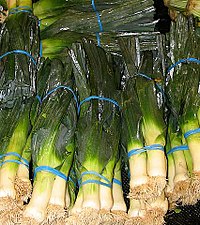Leek
This article needs attention from an expert on the subject. Please add a reason or a talk parameter to this template to explain the issue with the article. |
| Leek | |
|---|---|

| |
| Scientific classification | |
| Kingdom: | |
| Division: | |
| Class: | |
| Order: | |
| Family: | |
| Genus: | |
| Species: | |
| Subspecies: | A. ampeloprasum var. porrum
|
| Trinomial name | |
| Allium ampeloprasum var. porrum | |
The leek (Allium ampeloprasum var. porrum (L.) J. Gay) is a vegetable belonging, with onion and garlic, to the Alliaceae, the onion family. Also in this species are two very different vegetables: the elephant garlic (Allium ampeloprasum var. ampeloprasum) grown for its bulbs, and kurrat which is grown for its leaves in Egypt and elsewhere in the Middle East. The leek is also sometimes classified as Allium porrum (L.)
Form
Rather than forming a tight bulb such as the onion, the leek produces a long cylinder of bundled leaf sheaths which are generally blanched by pushing soil around them (trenching). They are often sold as small seedlings in flats which are begun early in greenhouses, to be set out as weather permits. Once established in the garden, leeks are hardy; many varieties can be left in the ground during the winter to be harvested as needed.
Cultivars
Leek cultivars can be subdivided in several ways, but the most common types are "summer leeks", intended for harvest in the season when planted, and overwintering leeks, meant to be harvested in the spring of the year following planting. Summer leek types are generally smaller than overwintering types; overwintering types are generally more strongly flavored.
Growing
Leeks are easy to grow from seed and tolerate standing in the field for an extended harvest. Leeks usually reach maturity in the autumn months, and they have few pest or disease problems. Leeks can be bunched and harvested early when they are about the size of a finger or pencil, or they can be thinned and allowed to grow to a much larger mature size. Hilling leeks can produce better specimens.
Cuisine

The edible portions are the white onion base and light green stalk. They are an essential ingredient of cock-a-leekie soup and of vichyssoise. They can also be used raw in salads, doing especially well when they are the prime ingredient.
Because of their symbolism in Wales (see below) they have come to be used extensively in that country's cuisine.
History
Dried specimens from archeological sites in ancient Egypt, as well as wall carvings and drawings led Zohary and Hopf to conclude that the leek was a part of the Egyptian diet "from at least the 2nd millennium bc onwards." They also allude to surviving texts that show it had been also grown in Mesopotamia from the beginning of the 2nd millennium BC.[1] The leek was the favorite vegetable of the Emperor Nero, who consumed it most often in soup form.
The leek is one of the national emblems of Wales, whose citizens wear it on St. David's Day. According to legend, King Cadwallader ordered his Welsh soldiers to identify themselves by wearing the vegetable on their helmets in an ancient battle against the Saxons that took place in a leek field. This story may have been made up by the English poet Michael Drayton but it is known that the leek has been a symbol of Wales for a long time; Shakespeare for example refers to the custom of wearing a leek as an "ancient tradition" in Henry V. In the play, Henry tells Fluellen he is wearing a leek "for I am Welsh, you know, good countryman". The 1985 and 1990 British One Pound coins bear the design of a leek in a coronet, representing Wales.
Trivia
- "Leek" can be used as a last name, particularly in the United Kingdom, though it is rather uncommon[citation needed].
-
Leek flowers
-
Two blooming flower heads
-
Closeup of a blooming flower head
- In Pokemon, there is a bird pokemon named Farfetch'd which carries a leek with it.
- Leekspin.com - A website which features how long you can listen to an anime girl sing a song who is spinning a leek.
See also
Notes
- ^ Daniel Zohary and Maria Hopf, Domestication of plants in the Old World, third edition (Oxford: University Press, 2000),p. 195
External links
- Allium ampeloprasum L. on US National PLANTS Database
- Allium porrum L. on US National PLANTS Database
- Allium ampeloprasum, Porrum on Floridata
- Leeks for the home gardener
- Leek: Plants For a Future database
- Food Museum page



